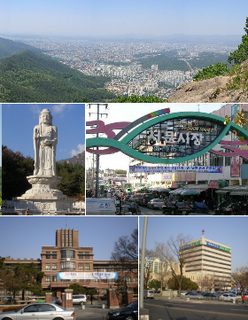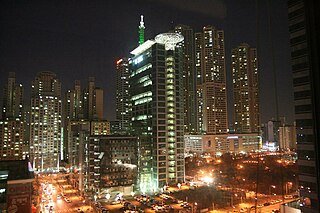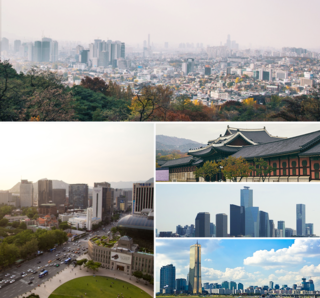Related Research Articles

Incheon, officially the Incheon Metropolitan City (인천광역시), is a city located in northwestern South Korea, bordering Seoul and Gyeonggi to the east. Inhabited since the Neolithic, Incheon was home to just 4,700 people when it became an international port in 1883. Today, about 3 million people live in the city, making it South Korea's third most-populous city after Seoul and Busan.

Busan, formerly romanized as Pusan and now officially Busan Metropolitan City, is South Korea's second most-populous city after Seoul, with a population of over 3.5 million inhabitants. It is the economic, cultural and educational center of southeastern South Korea, with its port—Korea's busiest and the fifth-busiest in the world —only about 190 kilometers (120 mi) from the Japanese islands of Kyushu and Honshu. The surrounding "Southeast Economic Zone" is South Korea's largest industrial area.

Gyeonggi Province is the most populous province in South Korea. Its name, Gyeonggi, means "the area surrounding the capital". Thus Gyeonggi-do can be translated as "province surrounding Seoul". The provincial capital is Suwon. Seoul—South Korea's largest city and national capital—is in the heart of the province but has been separately administered as a provincial-level special city since 1946. Incheon—South Korea's third-largest city—is on the coast of the province and has been similarly administered as a provincial-level metropolitan city since 1981. The three jurisdictions are collectively referred to as Sudogwon and cover 11,730 km2 (4,530 sq mi), with a combined population of 25.5 million—amounting to over half of the entire population of South Korea.

Daegu, formerly spelled Taegu and officially known as the Daegu Metropolitan City, is a city in South Korea, the third-largest after Seoul, and Busan, and also the third-largest metropolitan area in the nation with over 2.5 million residents. Daegu and surrounding North Gyeongsang Province are often referred to as Daegu-Gyeongbuk, with a total population over 5 million.

The Gyeongin Expressway, officially Expressway No. 120, is an expressway in South Korea connecting the Yangcheon District of Seoul to the Nam District of Incheon. It is the oldest expressway in South Korea.

Kaesong is a city in North Hwanghae Province in the southern part of North Korea, a former Directly Governed City and the capital of Korea during the Taebong kingdom and subsequent Goryeo dynasty. The city is near the Kaesong Industrial Region close to the border with South Korea and contains the remains of the Manwoldae palace. Called Songdo while it was the ancient capital of Goryeo, the city prospered as a trade centre that produced Korean ginseng. Kaesong now functions as the DPRK's light industry centre.

Bucheon is a city in Gyeonggi Province, South Korea. Bucheon is a satellite city of Seoul, 25 kilometres away. This city is located between Incheon and Seoul.

Tianmian sauce, also known as sweet bean sauce, sweet flour sauce or sweet wheat paste, is a thick, smooth, dark brown or black paste with either a mild, savory or sweet flavor. It is commonly used in Northern Chinese cuisine, Northeastern Chinese cuisine, as well as Korean-Chinese cuisine. Peking duck and jajangmyeon are two popular dishes that feature the sauce.

Bundang-gu is the largest and most populous district (gu) of Seongnam, a major city in the Seoul Capital Area, South Korea. Bundang-gu is one of South Korea's wealthiest and highest developed areas, being the nation's first and largest completely artificial city built in the early 1990s. Many high-rise luxury condos moved in the early 2000s, with a second planned city built in the late 2000s called Pangyo in the same district. Apartment prices are the second highest in Gyeonggi-do after Gwacheon and 10th highest nationwide, higher than many central Seoul districts such as Mapo-gu or Jongno-gu. Apartments around Pangyo Station and the high-rise luxury condos around Jeongja Station and Sunae Station rival prices in the most expensive areas in the country. Unlike older cities such as Seoul, Bundang has no telephone poles overground, resulting in a clean cityscape with well-designed streets.

Jajangmyeon (자장면) or jjajangmyeon (짜장면) is a Korean-style Chinese noodle dish topped with a thick sauce made of chunjang, diced pork, and vegetables. A variant of the dish uses seafood.

Yangcheon District (Yangcheon-gu) is a gu, or district, of Seoul, South Korea, located on the southwest side of the Han River. At the centre of this district is the Mok-dong area, which is home to numerous shopping outlets, bars and restaurants, an ice rink, and large residential buildings inhabited by mostly middle and upper-class families.

Seo District (Seo-gu) is the largest district in Incheon, South Korea. It has an area 111.2 square kilometres (42.9 sq mi), and it has the largest area of farmland in Incheon.

Incheon's Chinatown is Korea's only official Chinatown. It is in Jung-gu and was formed in 1884. It claims to be the largest Chinatown in South Korea, and features an 11-meter high Chinese-style gateway, or paifang. As of 2007 few ethnic Chinese live in the Incheon Chinatown. There are both many food and various attractions in Incheon chinatown.

Incheon Station is a railway station on line 1 and Suin Line of the Seoul Metropolitan Subway systems in Bokseong Dong, Jung Gu, Incheon, South Korea. Travel time from Incheon Station to Seoul Station on Line 1 is 68 minutes, and travelling to Suwon Station in Gyeonggi-do, on the other branch of Line 1 takes 91 minutes, transferring at Guro. Incheon is Station 161 and K269.

Bupyeong District (Bupyeong-gu) is one of the 10 administrative divisions that comprise Incheon, South Korea. Bupyeong-gu comprises an area of 12.35 square miles, and has a population of 544,606. It is located north of Namdong-gu, east of Seo-gu, and south of Gyeyang-gu. The city of Bucheon, in neighboring Gyeonggi Province, comprises its eastern limit.

Jung District is the historic central ward of the city of Incheon, South Korea, one of the eight wards into which Incheon is divided. Its name means "central" in Korean. It was founded in 1883 on the opening of the Jemulpo Port and contains several historical and cultural heritage monuments, such as Dap-dong Cathedral, Hongyemun Gate, The First Anglican Church, and Jayu Park, Korea's first modern park.

Michuhol District (Michuhol-gu) is a municipal district in Incheon, South Korea. This district was called Nam (South) District until July 1, 2018.

Seoul, officially the Seoul Special City, is the capital and largest metropolis of South Korea. With the surrounding Incheon metropolis and Gyeonggi province, Seoul forms the heart of the Seoul Capital Area. Ranked as an alpha world city, Seoul was the world's 4th largest metropolitan economy with a GDP of US$635 billion in 2014 after Tokyo, New York City and Los Angeles. International visitors generally reach Seoul via AREX from the Incheon International Airport, notable for having been rated the best airport for nine consecutive years (2005–2013) by the Airports Council International. In 2015, it was rated Asia's most livable city with the second highest quality of life globally by Arcadis, with the GDP per capita (PPP) in Seoul being around $40,000. In 2017, the cost of living in Seoul was ranked 6th globally. In 2018, Seoul's real estate market was ranked 5th in the world for the price of apartments in the downtown center., Seoul was one of the host cities for the official tournament of the 2002 FIFA World Cup in Korea/Japan.
Siheung County, alternatively Shihŭng County was a county (gun) in Gyeonggi Province, South Korea. This county was abolished in 1989 as its one town(읍) of Sorae and two townships(면) of Gunja and Suam became Siheung City at the same time. Today's Siheung City area did not belong to Siheung County before 1914. The area rather was part of old Incheon or Ansan.

The Jajangmyeon Museum (Korean:짜장면박물관) is a museum in Jung District, Incheon, South Korea about Jajangmyeon noodle.
References
- ↑ 북성동 유래, 2012년 7월 30일 확인
- ↑ "Jajangmyeon Museum | Incheon". AFAR. Retrieved 2017-08-17.
| This South Korea location article is a stub. You can help Wikipedia by expanding it. |